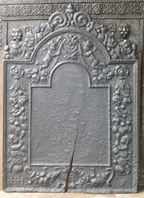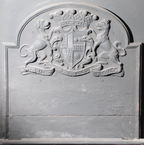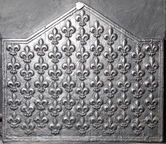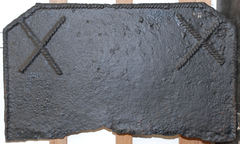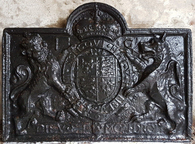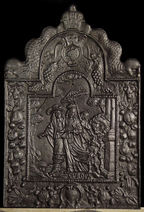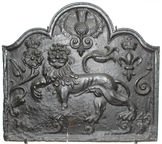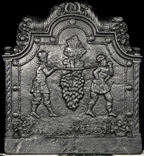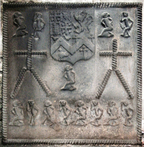-
1004
Description: Arched rectangular shaped central panel with bead edging; arched rectangular border with bead edging; fructal and floral festoons suspended on ribbons with two putti at the top and two on each side; in the left and right bottom corners, the initials 'HH' and 'S' respectively; at the bottom, a central cartouche with date (indistinctly), between floral swags; on top, twin spirals between descending floral festoons.
Notes: A border panel, without the central pictorial panel.
Copies of this fireback are known.
Inscription: HH S
Manufactured: in 1665 in the Siegerland area of Germany.
Current location: not known.
- Attached to series:
- 'Dutch' HHS series
- Base boards
-
249
Description: Arched rectangular shape; astragal and fillet edging; shield, motto, earl’s coronet and supporters (a talbot erm. and a wolf or, ducally crowned gu.) of Stanhope impaling Pitt: quarterly (1st & 4th) erm. (2nd & 3rd) gu. (Stanhope); sa., a fess chequy az. and ar. between three bezants (Pitt); motto: A DEO ET REGE.
Notes: James Stanhope was created 1st Earl in 1718; he had married Lucy Pitt in 1714. The Stanhope seat was Chevening, near Sevenoaks.
Inscription: A DEO ET REGE
Arms: Stanhope impaling Pitt; James, 1st Earl Stanhope
- Decoration tags:
- rectangular with round arch (shape)
- astragal & fillet (edging)
- carved pattern panels
- armorial
Manufactured: in the early-18th century in England.
Current location: Chevening Park, Chevening, Kent, England.
- Attached to series:
- Personal armorial firebacks
- Stanhope series
-
85
Description: Rectangular; twisted rope edging; twisted rope arranged to form inscription across upper half of plate.
Notes: The double 'v' may have an apotropaic significance, invoking the Virgin Mary.
Inscription: +W+
- Decoration tags:
- rectangular (shape)
- rope (edging)
- simple stamps
- apotropaic
- objects
Manufactured: in the mid- to late-16th century possibly in the Weald area of England.
Current location: in private hands, Hadlow Down, East Sussex, England.
- Attached to series:
- Rope design firebacks
-
88
Description: Rectangular with triangular arch; stepped fillet edging; eleven columns of fleurs de lys, maximum seven in column, but varied according to space, with fleurs alternated for spacing.
Notes: Whole pattern with five vertical planklines; a field of small fleurs de lys, France Ancient in royal heraldry, might suggest a continental origin.
Copies of this fireback are known.
- Decoration tags:
- rectangular with triangular arch (shape)
- stepped fillet (edging)
- whole carved pattern
- planklines
- heraldic
- objects
Manufactured: in the late-16th to early-17th century possibly in the Weald area of England.
Current location: Hampton Court, Richmond, Greater London, England.
- Attached to series:
- Miscellaneous royal firebacks
-
455
Description: Canted rectangle; twisted rope edging (top and sides); a rope saltire in each top corner.
Notes: The edging is made from the same, short lengths of rope as the saltires.
- Decoration tags:
- rectangular with canted top corners (shape)
- rope (edging)
- simple stamps
- apotropaic
- objects
Manufactured: in the 16th century in the Weald area of England.
Current location: Hall Place, Bexley, Kent, England.
Museum number: 1944.24.049 (part of the Sussex Archaeological Society museum group)
- Attached to series:
- Rope design firebacks
-
977
Description: Arched rectangular shape; ovolo moulded edging; Tudor royal shield, garter, crown, motto and supporters (crowned lion and dragon), temp. Elizabeth I; initials in space on either side of top of garter; the top of the lion's crown and the dragon's ear overlap the edging.
Notes: The initials have been added to an early recasting; another version has a rose and portcullis either side of the crown, and the top of the lion's crown and the dragon's ear do not overlap the edging.
Copies of this fireback are known.
Inscription: I G / [Garter] HONI SOIT QVI MAL E PENSE / [motto] DIEV ET MON DROIT
Arms: Tudor royal
- Decoration tags:
- rectangular with round arch (shape)
- ovolo (edging)
- whole carved pattern
- individual letters
- planklines
- armorial
- royal
- text
Manufactured: in the mid- to late-16th century possibly in the Weald area of England.
Current location: not known.
- Attached to series:
- Tudor royal armorial firebacks
- Tudor royal armorial (plain) series
-
720
Description: Arched rectangular central panel with bead-on-fillet edging, pictorial representation of a man and woman walking, behind the woman a child holds her train and a young person carries a parasol; from behind a column on the right, a horse's head is visible, a tree stands to the left, at the foot of the scene is the word 'EVROPA'; tall-arched rectangular border with fillet edging; at top of arch, a lion's head above a ring, with descending grape vines on each side; at each side, a festoon of fruit suspended on a ribbon from a lion's head; at the bottom, an oval cartouche between flowers; on top, a Holy Roman Imperial crown between two descending dolphins.
Notes: The pictorial scene is based on an engraving c.1642 of Friedrich Wilhelm, Elector of Brandenburg, and his wife, Luise Henriette of Oranje-Nassau, by Mathias Czwiczek; one of series of firebacks depicting allegories of the four continents.
Copies of this fireback are known.
Inscription: EVROPA
- Decoration tags:
- 'Dutch' (shape)
- fillet (edging)
- whole carved pattern
- pictorial
- architectural
- text
- humans
- plants
Manufactured: in the mid- to late-17th century in the Siegerland area of Germany.
Current location: not known.
- Attached to series:
- 'Dutch' Miscellaneous Firebacks
- 'Dutch' Continents firebacks
-
763
Description: Quasi-Arched rectangular shape with cyma reversa shoulders; ovolo edging; stylised lion passant guardant; crowned rose with leaf and stem on left, crowned fleur de lys on right, thistle with leaves above centre; three right-facing scrolls at base; down-facing scroll, with staple, on right side; date split between bottom corners; initials below date, bottom right.
Notes: Blatantly Royalist in its symbolism, a variant (no. 901) is dated (perhaps more convincingly) 1641. Numeral style, initials, leaf depiction and the stapled scroll are typical features of firebacks made from patterns by the same maker. A later version of the same subject, but with a different shaped plate and without the fleur-de-lys, is also known (see 'Royalist series'). M. A. Lower writes of firebacks of this design of being cast at Waldron Furnace in Sussex (Lower, 1849, p.219).
Copies of this fireback are known.
Inscription: 16 49 / IM
- Decoration tags:
- rectangular with round arch (shape)
- ovolo (edging)
- whole carved pattern
- heraldic
- royal
- text
- animals
Manufactured: in 1649 possibly at Brede Furnace in the Weald area of England.
Current location: Victoria & Albert Museum, Cromwell Road, Kensington & Chelsea, Greater London, England.
Museum number: 492.1901 (part of the Victoria & Albert Museum museum group)
Citation: Lloyd, N., 1925, 'Domestic Ironwork I', Architectural Review, 58, pp. 58-67.
- Attached to series:
- IM series
- Hooked '1' series
- Stapled scroll series
- Brede group
-
944
Description: Cavetto-canted arched rectangular shape; double fillet edging on top, pilasters with diagonal striping at sides; double bead and pellet moulding parallel to, and inside fillet, enclosing pictorial representation of Joshua and Caleb carrying an outsize bunch of grapes; below them, at each side, a basket of flowers and fruit, and between them a cartouche with a date; on top, two symmetrical cornucopiae spilling their contents down the canted shoulders of the plate; at bottom, a plain extension panel.
Notes: The image is derived from a fireback of c.1700, in the series identified by the letters GK, as is the date cartouche. This is a contrived design using elements from another fireback.
Inscription: [indecipherable poss. 1700]
- Decoration tags:
- rectangular with canted top corners and round arch (shape)
- complex individual (edging)
- carved pattern panels
- extension panels
- pictorial
- biblical
- text
- humans
- plants
Manufactured: in the 19th century in France.
Current location: not known.
- Attached to series:
- Joshua and Caleb firebacks
- 'Dutch' GK series
-
920
Description: Rectangular; twisted rope edging; top centre, quartered shield between four 'imp' figures, left facing, one with right arm raised, one of each on each side; below each pair of figures, a rope cross above an inverted V in rope, with an 'imp' figure, arms lowered, below the shield; along the bottom, eight 'imp' figures, alternately arms raised and lowered.
Notes: The 'imp' figures are common on a group of firebacks, the rope designs having a probable apotropaic significance. The arms are probably of Thomas Wriothesley, who was Henry VIII's last Lord Chancellor and created Earl of Southampton in 1547; he married c.1533 so the arms could date to before then, but the same arms are displayed on his enamelled stall plate in St George's Chapel, Windsor, of 1545, and in stained glass in a window in the parish church at South Warnborough, Hampshire. The shield is, quarterly, 1. Wrythe or Wriothesley quartering Dunstanville and Pink, 2. Drayton, 3. Crocker and 4. Peckham. The same armorial stamp has been noted on at least two other firebacks. A candidate for the earliest English fireback with an example of personal arms.
Arms: Wriothesley (Earl of Southampton)
- Decoration tags:
- rectangular (shape)
- rope (edging)
- simple stamps
- carved stamps
- apotropaic
- armorial
- humans
- objects
Manufactured: in the mid- to late-16th century in the Weald area of England.
Current location: in private hands, Wigmore, Herefordshire, England.
- Attached to series:
- Royal series
- Personal armorial firebacks
- Wriothesley firebacks
